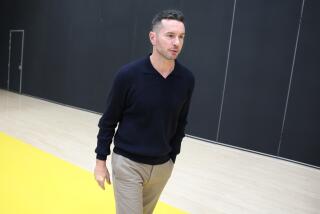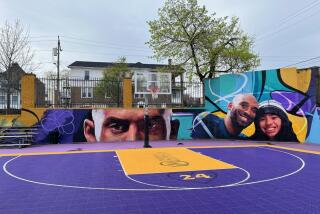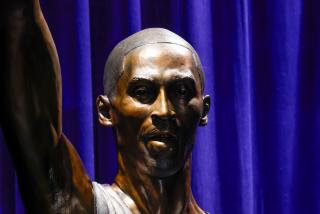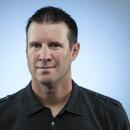The MVP of video
- Share via
There are few things more important to Kobe Bryant before a game than his portable DVD player.
It goes wherever he goes before tipoff. On the padded table in the trainer’s room. On the floor for a pregame stretching routine. Perched in front of his locker.
The Lakers’ 10-time All-Star stares at his 10-inch screen, watching basketball clips of the players he’ll be guarding.
It is part of his longtime commitment to studying video, one of the foundations of a career still going strong in its 13th season.
The Lakers have had their stars over the last few decades -- Magic Johnson, Kareem Abdul-Jabbar, Jerry West, Shaquille O’Neal -- but few have studied game video (or film, as it was called back in the day) more diligently than Bryant, who looks for the slightest advantage while sizing up an opponent.
“Hands down, he’s the biggest video fiend we’ve ever had,” said Chris Bodaken, the Lakers’ director of video services. “I didn’t know if it was possible to be more competitive than Magic was, but I think he might be. It carries over into his preparation, and this is part of that.”
Bodaken, 40, began working in the Lakers’ editing room in 1989 as an intern and is now one of two full-time staffers who use eight digital video recorders, five laptop computers and 18 DVD burners to record, edit and copy footage for Lakers coaches and players.
NBA teams are inundated with video, part of an effort to keep up with the competition in the digital age. The Lakers’ video staff has been even busier this season because Bryant, 30, has dialed up his requests after winning his first NBA most-valuable-player award.
Bryant previously studied clips from entire games, watching them at his home or on the way to home games in his car (he is typically driven by one of his bodyguards). Now his pregame routine also includes clips of individual players he will guard.
Bodaken’s co-worker, Patrick O’Keefe, 28, is in charge of compiling Bryant’s video montages.
After conferring with Bryant, O’Keefe takes a little more than an hour to scroll through an opponent’s last few games and find key plays from the players Bryant will guard, presenting him with eight to 12 minutes of edited footage.
The goal is for Bryant to pick up tendencies of rival players. Have they added any new moves? Have they been aggressively driving to the basket or have they been satisfied to drift from the hoop and settle for outside jump shots?
Before games, Bryant slips in custom-made earpieces with “KB” monograms on each side. Then he turns on his DVD player and tries to find ways to take away comfort zones from opponents.
For the Christmas Day game against Boston, he received 12 edited minutes of three Celtics starters: Paul Pierce, Rajon Rondo and Ray Allen. Less than 48 hours later, he received 11 minutes of three Golden State players: Stephen Jackson, Kelenna Azubuike and Marco Belinelli.
“It’s a blueprint,” said Bryant, an eight-time member of the NBA all-defensive team. “So if something goes down, it’s not something you haven’t seen before. Everybody’s got tendencies. If he scores 40 on Monday, he’s going to try to do it on Tuesday. You’ve got to take him out of his spots. That’s the key.”
Bryant has studied basketball footage since he was a 6-year-old in Italy, where his father, Joe “Jellybean” Bryant, played professionally after an eight-year NBA career.
Bryant’s grandfather would send video tapes to Italy of NBA games, and Bryant would eagerly pop them into the bulky tape machines of the 1980s. NBA games were not televised in Europe, so Bryant depended on the boxes from his grandfather to be able to imitate U.S. professionals.
“When I saw a hot move, I could rewind it and go back and watch it and learn from it,” Bryant said. “It started real early.”
It continued at Lower Merion (Pa.) High, where Bryant played high school basketball after his family moved to Philadelphia. Bryant said his high school coach, Gregg Downer, was a “big believer” in breaking down video.
“He had everybody watching game film even back then when it wasn’t as popular to do it,” Bryant said. “He would scout out our opponents’ games, videotape our opponents’ games, and we would watch game tape of them.”
Bryant graduated from high school in 1996 and played his first NBA game as an 18-year-old, where his film fascination continued.
He asked Lakers video coordinators for tapes on players from the late 1980s and early-to-mid 1990s, including revered Chicago Bulls guard Michael Jordan.
When the Lakers hired Phil Jackson in 1999, Bryant was tipped off that his new coach sometimes asked video coordinators to edit random on-screen words into video packages viewed by the entire team before practice. Jackson would then ask a particular player which word just flashed on the screen, the equivalent of a pop quiz for multi-millionaire athletes.
“I remember mentioning that to Kobe once and he just laughed,” Bodaken said. “The concept of not watching something on film was so foreign to him.”
The Lakers originally began using game footage to scout teams in the late 1960s, splicing together plays on 8-mm or 16-mm film, according to longtime Lakers official Bill Bertka. Sessions were short, perhaps only five or six minutes, and if the film projector broke, a common occurrence back then, “the players would go bananas,” he said.
Bodaken and O’Keefe cull their videos from a vast menu of programming. The NBA provides a television package so the Lakers can download any game. The Lakers’ video staff members will program games -- sometimes a week in advance -- on the team’s video systems at Staples Center or the Lakers’ El Segundo practice facility.
On Monday night, they recorded Denver vs. Atlanta, Orlando-Detroit, Chicago-New Jersey, Memphis-Minnesota, Phoenix-Oklahoma City, Washington-Houston, Philadelphia-Utah, and Toronto-Golden State.
Bodaken, who also scouts for the Lakers and spent one season as an assistant coach, boasts about the football conquests of his alma mater, USC. O’Keefe is a former student manager for the Indiana University men’s basketball team.
Their work space at Staples Center is just large enough to accommodate two desks and three steel racks of recording equipment.
The room is next to Jackson’s office, allowing for easy access if he has a particular video request.
When the Lakers are on the road, either O’Keefe or Bodaken travels with them.
When the Lakers are at home, the video staff typically arrives at the team’s training facility before 7 a.m. Morning is crunch time because videos must be ready by the time practice starts at 10 a.m. Also, edited DVDs of upcoming opponents must be prepared for coaches so that future game plans can be formulated.
Game days are particularly long. Bodaken and O’Keefe stay at Staples Center until 11 p.m., awaiting word from coaches on what must be prepared for the next day. Before tipoff, the opponent’s most recent game is always showing on a large TV in the locker room as players arrive 90 minutes before a game. Few of them watch it, preferring instead to shoot on the court or relax in an adjacent players’ lounge.
Bryant, however, is often in the trainer’s room watching his DVD player while his ankles are taped.
Says O’Keefe: “It’s like a straight-A student who still goes to all the extra study sessions.”
--
--
Up next
LAKERS VS. UTAH
Friday at Staples Center
7:30 p.m., FS West
More to Read
All things Lakers, all the time.
Get all the Lakers news you need in Dan Woike's weekly newsletter.
You may occasionally receive promotional content from the Los Angeles Times.








